Far-right politics
Far-right politics are politics further on the right of the left-right spectrum than the standard political right, particularly in terms of extreme nationalism,[1][2] nativist ideologies, and authoritarian tendencies.[3][4]
| Part of the Politics series | ||||||
| Party politics | ||||||
|---|---|---|---|---|---|---|
| Political spectrum | ||||||
|
||||||
| Party platform | ||||||
|
||||||
| Party system | ||||||
|
||||||
| Coalition | ||||||
|
||||||
| Lists | ||||||
|
||||||
| Politics portal | ||||||
Used to describe the historical experiences of fascism and Nazism,[5] it today includes neo-fascism, neo-Nazism, Third Position, the alt-right, white nationalism[6] and other ideologies or organizations that feature ultranationalist, chauvinist, xenophobic, theocratic, racist, homophobic, anti-communist, or reactionary views.[7] These can lead to oppression, violence, forced assimilation, ethnic cleansing, and even genocide against groups of people based on their supposed inferiority, or their perceived threat to the native ethnic group,[8][9] nation, state,[10] national religion, dominant culture or ultraconservative traditional social institutions.[11]
Definition
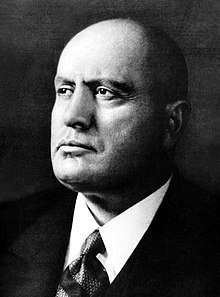
The core of the far-right's worldview is organicism, the idea that society functions as a complete, organized and homogeneous living being. Adapted to the community they wish to constitute or reconstitute (whether based on ethnicity, nationality, religion or race), the concept leads them to reject every form of universalism in favor of autophilia and alterophobia, in other words the idealization of a "we" excluding a "they". The far-right thus tends to absolutize differences between nations, races, individuals or cultures since they disrupt their efforts towards the utopian dream of the organicist community, reconnected to its quasi-eternal nature and established on firm metaphysical foundations.[4][12] As they view their community in a state of decay facilitated by the ruling elites, far-right members portray themselves as a natural, sane and alternative elite, with the redemptive mission of saving society from its promised doom. The current political order is presented as needing to be abandoned or purged of impurity, so that the "redemptive community" can leave the phase of liminal crisis to usher in the new era.[12] The community itself is idealized through great archetypal figures (the golden age, the savior, decadence, global conspiracies), as they glorify irrationalistic and non-materialistic values such as the youth or the cult of the past.[13]
Political scientist Cas Mudde defines the far-right as a combination of four broad concepts: exclusivism (i.e., racism, xenophobia, ethnocentrism, or ethnopluralism); antidemocratic, non-individualist traits (i.e., cult of personality, hierarchism, monism, populism, antipartyism, an organicist view of the state); a traditionalist value system lamenting the disappearance of historic frames of reference (i.e., law and order, the family, the ethnic, linguistic and religious community and nation, as well as the natural environment); and a socioeconomic program associating corporatism, state control of certain sectors, agrarianism and a varying degree of belief in the free play of socially darwinistic market forces. Mudde then proposes a subdivision of the far-right nebula into moderate and radical leanings, according to their degree of exclusionism and essentialism.[14][15]
Far-right politics includes but is not limited to aspects of authoritarianism, anti-communism and nativism.[3] Claims that superior people should have greater rights than inferior people are often associated with the far-right,[16] as they have historically favored a darwinistic or elitist hierarchy based on the belief in the legitimacy of the rule of a supposed superior minority over the inferior masses.[17]
Modern debates
According to Jean-Yves Camus and Nicolas Lebourg, the modern ambiguities in the definition of the "far-right" lie in the fact that the concept is generally used by political adversaries to "disqualify and stigmatize all forms of partisan nationalism by reducing them to the historical experiments of Italian Fascism [and] German National Socialism." While the existence of such a political position is widely accepted among scholars, figures associated with the far-right rarely accept this denomination, preferring terms like "national movement" or "national right".[18] There is also debate about how appropriate the labels fascist or neo-fascist are. In the words of Mudde, "the labels Neo-Nazi and to a lesser extent neo-Fascism are now used exclusively for parties and groups that explicitly state a desire to restore the Third Reich or quote historical National Socialism as their ideological influence".[19]
Aspects of fascist ideology can be identified in the agenda of some contemporary right-wing parties, in particular the idea that superior persons should dominate society while undesirable elements should be purged—which in the case of Nazism resulted in genocide.[20] Charles Grant, director of the Centre for European Reform in London, has distinguished between right-wing nationalist parties—which are often described as far-right such as the National Front in France—and fascism.[1] One issue is whether parties should be labelled radical or extreme,[19] a distinction that is made by the Federal Constitutional Court of Germany when determining whether or not a party should be banned: an extremist party opposes liberal democracy and the constitutional order, while a radical one accepts free elections and the parliament as legitimate structures.[21] Another question is what the label "right" implies when it is applied to the extreme right, given the fact that many parties that were originally labeled right-wing extremist tended to advance neoliberal and free market agendas as late as the 1980s, but now advocate economic policies which are more traditionally associated with the left, such as anti-globalization, nationalization and protectionism. One approach, drawing on the writings of Norberto Bobbio, argues that attitudes towards political equality are what distinguish the left from the right and they therefore allow these parties to be positioned on the right of the political spectrum.
Right-wing populism, a political ideology that often combines laissez-faire capitalism, nationalism, ethnocentrism and anti-elitism, is sometimes described as far-right.[22][23] Right-wing populism often involves appeals to the "common man" and opposition to immigration.[24][1] Far-right politics sometimes involves anti-immigration and anti-integration stances towards groups that are deemed inferior and undesirable.[25] Concerning the socio-cultural dimension of nationality, culture and migration, one far-right position is the view that certain ethnic, racial or religious groups should stay separate and it is based on the belief that the interests of one's own group should be prioritized.[26]
Proponents of the horseshoe theory interpretation of the left-right spectrum identify the far-left and the far-right as having more in common with each other as extremists than each of them has with moderate centrists.[27]
History
Europe
The current admitted divisions on the political spectrum come from the different positions held by elected representatives regarding the outcomes of the French Revolution: the democrats and proponents of universal suffrage were located on the left side of the elected Assembly, while monarchists seated farthest to the right.[18] Those who advocated a return to the absolute monarchy during the 19th century called themselves "ultra-monarchists", and embraced a "mystic" and "providentialist" vision of the world where royal dynasties were seen as the "repositories of divine will". The counter-revolutionary and the liberal camps began to transcend the borders of Europe during the first globalization (1870–1914), and a number of the ideas that currently constitute the foundation of far-right ideology—nationalism, populism, or antisemitism—were defended at that time by parts of the revolutionary left, a confusion observable in the writings of Sorel, Michels, Woltmann, or Proudhon.[28][29][30]
The word "extremist" to designate a category of the political spectrum appeared in the French public debate following the Bolshevik revolution of 1917:[lower-alpha 1] "far right" was used at that time to describe the strongest opponents of the "far left"—those who supported the events occurring in Russia.[4] A number of thinkers on the far-right nonetheless claimed an influence from an imprecisely defined idea of socialism, based on a military comradeship that rejected class analysis[lower-alpha 2]—sometimes called "socialist revisionism":[31] Charles Maurras, Benito Mussolini, Arthur Moeller van den Bruck, or Ernst Niekisch.[32][33][34] They eventually split along nationalist lines from the original communist movement, Karl Marx and Friedrich Engels contradicting nationalist theories with the idea that "the working men [had] no country".[35] The main reason for that ideological confusion can be found in the consequences of the Franco-Prussian War of 1870 which, according to Swiss historian Philippe Burrin, had completely redesigned the political landscape in Europe by diffusing the idea of an anti-individualistic concept of "national unity" rising above the right and left division.[34] As the concept of the masses was introduced into the political debate through industrialization and the universal suffrage, a new right-wing founded on national and social ideas began to emerge, what Zeev Sternhell called the "revolutionary right", and a foreshadowing of fascism. The rift between the left and nationalists was furthermore accentuated by the emergence of anti-militarist and anti-patriotic movements in anarchism and syndicalism, which shared even less similarities with the far-right.[35] The latter began to develop a "nationalist mysticism" entirely different from that on the left, and antisemitism turned into a credo of the far-right, marking a break from traditional "anti-Judaism" in favor of a racial and scientific notion. Various nationalist leagues began to form across Europe like the Pan-German League or the Ligue des Patriotes, with the common goal of a uniting the masses beyond social divisions.[36][37]
_-_Fondo_Mar%C3%ADn-Kutxa_Fototeka.jpg)
The Völkisch movement emerged in the late 19th century, drawing inspiration from German Romanticism and its fascination for a medieval Reich supposedly organized into a harmonious hierarchical order. Erected on the idea of "blood and soil", it was a racialist, populist, agrarian, romantic nationalist, and from the 1900s antisemitic movement.[38] They idealized the myth of an "original nation", that still could be found at their times in the rural regions of Germany, a form of "primitive democracy freely subjected to their natural elites."[33] Thinkers led by Arthur de Gobineau, Houston Stewart Chamberlain, Alexis Carrel and Georges Vacher de Lapouge distorted Darwin's theory of evolution to advocate a "race struggle" and an hygienist vision of the world. The purity of the bio-mystical and primordial nation theorized by the Völkischen then began to be seen as corrupted by foreign elements, Jewish in particular.[38] Translated in Maurice Barrès' concept of "the earth and the dead", these ideas influenced the pre-fascist "revolutionary right" across Europe. The latter had its origin in the fin de siècle intellectual crisis and, in the words of Fritz Stern, the deep "cultural despair" of thinkers feeling uprooted within the rationalism and scientism of the modern world.[39] It was characterized by a rejection of the established social order, with revolutionary tendencies and anti-capitalist stances; a populist and plebiscitary dimension; the advocacy of violence as a means of action; and a call for individual and collective palingenesis.[40]
German political scientist Klaus von Beyme describes three historical phases in the development of far-right parties in Western Europe after World War II.[26] From 1945 to the mid-1950s, far-right parties were marginalized and their ideologies were discredited due to the recent existence and defeat of Nazism. Thus in the years immediately following World War II, the main objective of far-right parties was survival and achieving any political impact at all was largely not expected.[41] From the mid-1950s to the 1970s, the so-called "populist protest phase" emerged with sporadic electoral success. During this period, far-right parties drew to them charismatic leaders whose profound mistrust of the political establishment led to an "us-versus-them" mind set: "us" being the nation's citizenry, "them" being the politicians and bureaucrats who were then in office. Beginning in the 1980s, the electoral successes of far-right political candidates made it possible for far-right political parties to revitalize anti-immigration as a mainstream issue.[41]
Nature of support
Jens Rydgren describes a number of theories as to why individuals support far-right political parties and the academic literature on this topic distinguishes between demand-side theories that have changed the "interests, emotions, attitudes and preferences of voters" and supply-side theories which focus on the programmes of parties, their organization and the opportunity structures within individual political systems.[42] The most common demand-side theories are the social breakdown thesis, the relative deprivation thesis, the modernization losers thesis and the ethnic competition thesis.[43]
The rise of far-right political parties has also been viewed as a rejection of post-materialist values on the part of some voters. This theory which is known as the reverse post-material thesis blames both left-wing and progressive parties for embracing a post-material agenda (including feminism and environmentalism) that alienates traditional working class voters.[44][45] Another study argues that individuals who join far-right parties determine whether those parties develop into major political players or whether they remain marginalized.[46]

Early academic studies adopted psychoanalytical explanations for the far-right's support. For example, the 1933 publication The Mass Psychology of Fascism by Wilhelm Reich argued the theory that fascists came to power in Germany as a result of sexual repression. For some far-right political parties in Western Europe, the issue of immigration has become the dominant issue among them, so much so that some scholars refer to these parties as "anti-immigrant" parties.[47]
Right-wing terrorism
Right-wing terrorism is terrorism motivated by a variety of far right ideologies and beliefs, including anti-communism, neo-fascism, neo-Nazism, racism, xenophobia and opposition to immigration. This type of terrorism has been sporadic, with little or no international cooperation.[2] Modern right-wing terrorism first appeared in western Europe in the 1980s and it first appeared in Eastern Europe following the dissolution of the Soviet Union.[48]
Right-wing terrorists aim to overthrow governments and replace them with nationalist or fascist-oriented governments.[2] The core of this movement includes neo-fascist skinheads, far-right hooligans, youth sympathisers and intellectual guides who believe that the state must rid itself of foreign elements in order to protect rightful citizens.[48] However, they usually lack a rigid ideology.[48]
By country
Australia
As of May 2019, there is a number of political parties to the right of the centre-right Liberal Party of Australia and National Party of Australia, many of a populist nature. These include Pauline Hanson's One Nation, Katter's Australian Party, Fraser Anning's Conservative National Party (created 2019), United Australia Party, the Australian Conservatives, Yellow Vest Australia (formerly Australian Liberty Alliance), the Australia First Party, The Great Australian Party, Love Australia or Leave and the Rise Up Australia Party.
In addition to the registered political parties, there is a host of nationalist, far right or neo-Nazi groups and individuals. These include the True Blue Crew, Antipodean Resistance, the Australian Defence League, National Action (Australia), the Q Society, Reclaim Australia and the Lads Society (formerly United Patriots Front).
The parties and groups enjoy varying levels of support, with membership waxing and waning and fairly frequent changes of name and allegiances.[49]
In the lead-up to the May 2019 election, extremist groups, some with members linked to far-right terrorism, have tried to present themselves as legitimate and exert influence on right-wing and far-right parties. According to Geoff Dean, counter-terrorism expert and adjunct professor at Griffith University, "There are two real camps of rightwing extremists: those of the old style that do believe in violence and those of the new style, the new radical right, who want to gain political legitimacy to...change laws to support their agenda." Kristy Campion, of Charles Sturt University, expert on far-right extremism and terrorism, says "These groups are very good at framing their messaging in such a way that it will gain popular appeal. It's not always blatantly racist...[but]...Fundamentally their ideology is anti-democratic."[49]
Many of Fraser Anning's party have links to white supremacism and some are convicted criminals. There has been attempted infiltration to the Liberal Democratic Party (a libertarian party), echoing the Lads Society's attempts to infiltrate the National Party in 2018.[49]
Germany
The far-right in Germany quickly re-organised itself after the fall of Nazi Germany and the dissolution of the Nazi Party in 1945. However, the National Democratic Party of Germany (NPD), founded in 1964 and the only neo-Nazi political party remaining, won their first state representations in the Saxony state election, 2004, the Mecklenburg-Vorpommern state election, 2006 and the 2014 European Parliament election.
Italy

Silvio Berlusconi and his Forza Italia party dominated politics from 1994, and gave neo-fascism a new respectability. Caio Giulio Cesare Mussolini, great-grandson of Benito Mussolini, stood for the 2019 European Parliament election, as the member of the far-right Brothers of Italy party. The European migrant crisis has become an increasingly divisive issue in Italy.[50] Interior Minister Matteo Salvini has been courting far-right voters. His Northern League Party has become an anti-immigrant, nationalist movement. Both parties are using Mussolini nostalgia to further their aims.[51]
United Kingdom
Far-right politics in the United Kingdom have existed since at least the 1930s, with the formation of Nazi, fascist and anti-semitic movements. It went on to acquire more explicitly racial connotations, being dominated in the 1960s and 1970s by self-proclaimed white nationalist organisations that opposed non-white and Asian immigration, such as the National Front (NF), the British Movement (BM) and British National Party (BNP), or the British Union of Fascists (BUF). Since the 1980s, the term has mainly been used to describe those groups, such as the English Defence League, who express the wish to preserve what they perceive to be British culture, and those who campaign against the presence of non-indigenous ethnic minorities and what they perceive to be an excessive number of asylum seekers.
The NF and the BNP have been strongly opposed to non-white immigration. They have encouraged the repatriation of ethnic minorities: the NF favours compulsory repatriation, while the BNP favours voluntary repatriation. The BNP have had a number of local councillors in some inner-city areas of East London, and towns in Yorkshire and Lancashire, such as Burnley and Keighley. East London has been the bedrock of far-right support in the UK since the 1930s, whereas BNP success in the north of England is a newer phenomenon. The only other part of the country to provide any significant level of support for such views is the West Midlands.
United States
In the United States, the term "hard right" has been used to describe groups such as the Tea Party movement and the Patriot movement.[52][53] The term has also been used to describe ideologies such as paleoconservatism, Dominion Theology and white nationalism.[54]
Other
Gallery
 Supporters of the historic Russian far-right Black Hundreds movement marching in Odessa in 1905
Supporters of the historic Russian far-right Black Hundreds movement marching in Odessa in 1905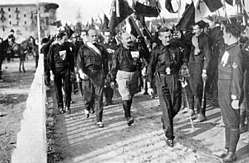
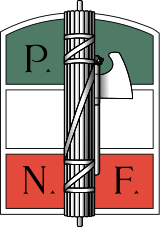 Emblem of the National Fascist Party
Emblem of the National Fascist Party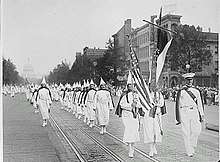 Members of the Ku Klux Klan (KKK), marching in a mass rally in Washington, D.C. in 1928
Members of the Ku Klux Klan (KKK), marching in a mass rally in Washington, D.C. in 1928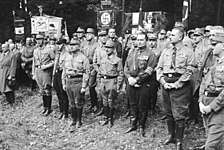 Nazis alongside members of German National People's Party (DNVP) in 1931 during the Nazi-DNVP alliance in the Harzburg Front
Nazis alongside members of German National People's Party (DNVP) in 1931 during the Nazi-DNVP alliance in the Harzburg Front.svg.png) The flag of Nazi Germany
The flag of Nazi Germany Members of the Croatian Black Legion of the Ustashe Militia in Sarajevo in 1942
Members of the Croatian Black Legion of the Ustashe Militia in Sarajevo in 1942
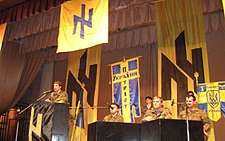
See also
- Alt-right
- Extremism
- Right-wing authoritarianism
- Right-wing terrorism
- Wingnut (politics)
- Far-left politics
References
Informational notes
- The word "extremist" can be found throughout the 19th century in parliamentary debates to designate the "extreme" positions of a group in a party; though not with the accepted categories of "extreme right" and "extreme left" that emerged in the 1870–90s. (see: "The Indian Year Books", or the "Parliamentary Debates" from Australia and New Zealand)
- What Oswald Spengler had called a "socialism of the blood".
Citations
- Baker, Peter (28 May 2016). "Rise of Donald Trump Tracks Growing Debate Over Global Fascism". The New York Times. ISSN 0362-4331. Retrieved 7 June 2016.
- Aubrey, Stefan M. The New Dimension of International Terrorism. p. 45. Zurich: vdf Hochschulverlag AG, 2004. ISBN 3-7281-2949-6
- Hilliard, Robert L. and Michael C. Keith, Waves of Rancor: Tuning in the Radical Right (Armonk, New York: M.E. Sharpe Inc., 1999, p. 43
- Camus, Jean-Yves; Lebourg, Nicolas (20 March 2017). Far-Right Politics in Europe. Harvard University Press. p. 21. ISBN 9780674971530.
- "Historical Exhibition Presented by the German Bundestag" (PDF).
- "Ctrl-Alt-Delete: The origins and ideology of the Alternative Right | Political Research Associates". www.politicalresearch.org. Retrieved 3 September 2019.
- Carlisle, Rodney P., ed., The Encyclopedia of Politics: The Left and the Right, Volume 2: The Right (Thousand Oaks, California, United States; London, England; New Delhi, India: Sage Publications, 2005) p. 693.
- Golder, Matt (11 May 2016). "Far Right Parties in Europe". Annual Review of Political Science. 19 (1): 477–497. doi:10.1146/annurev-polisci-042814-012441.
- http://mattgolder.com/files/research/arps.pdf
- Hilliard, Robert L. and Michael C. Keith, Waves of Rancor: Tuning in the Radical Right (Armonk, New York: M.E. Sharpe, Inc., 1999) p. 38.
- Peter Davies; Derek Lynch (2002). The Routledge Companion to Fascism and the Far Right. Psychology Press. ISBN 978-0-415-21494-0. Retrieved 19 August 2011.
In addition, conservative Christians often endorsed far-right regimes as the lesser of two evils, especially when confronted with militant atheism in the USSR.
- Bar-On, Tamir (5 December 2016). Where Have All The Fascists Gone?. Routledge. ISBN 9781351873130.
- Camus, Jean-Yves; Lebourg, Nicolas (20 March 2017). Far-Right Politics in Europe. Harvard University Press. p. 22. ISBN 9780674971530.
- Mudde, Carl. "The Extreme Right Party Family: An Ideological Approach" (PhD diss., Leiden University, 1998).
- Camus, Jean-Yves; Lebourg, Nicolas (20 March 2017). Far-Right Politics in Europe. Harvard University Press. pp. 44–45. ISBN 9780674971530.
- Oliver H. Woshinsky. Explaining Politics: Culture, Institutions, and Political Behavior. (Oxon, England; New York City, United States: Routledge, 2008) p. 155.
- Oliver H. Woshinsky. Explaining Politics: Culture, Institutions, and Political Behavior. (Oxon, England; New York City, United States: Routledge, 2008) p. 154.
- Camus, Jean-Yves; Lebourg, Nicolas (20 March 2017). Far-Right Politics in Europe. Harvard University Press. pp. 1–2. ISBN 9780674971530.
- Mudde, Cas (2002). The Ideology of the Extreme Right. Manchester University Press. p. 12. ISBN 978-0-7190-6446-3.CS1 maint: ref=harv (link)
- Woshinsky, Oliver H., Explaining Politics: Culture, Institutions, and Political Behavior (Oxon, England; New York City, United States: Routledge, 2008) p. 156.
- Minkenberg, Michael (1998). "Context and Consequence: The Impact of the New Radical Right on the Political Process in France and Germany". German Politics & Society. 16 (3 (48)): 1–23. doi:10.3167/104503098782487095. ISSN 1045-0300. JSTOR 23737372.
- Ware, Alan (1996). Political Parties and Party Systems. Oxford University Press. ISBN 978-0-19-878076-2.
- Norris, Pippa (2005). Radical Right: Voters and Parties in the Electoral Market. Cambridge, England: Cambridge University Press. ISBN 978-0-521-84914-2.
- Betz and Immerfall, pp. 4–5
- Parsons, Craig and Timothy M. Smeeding, Immigration and the transformation of Europe (Cambridge University Press, 2006) p. 18.
- Widfeldt, Anders, "A fourth phase of the extreme right? Nordic immigration-critical parties in a comparative context". In: NORDEUROPAforum (2010:1/2), 7–31, Edoc.hu
- William Safire. Safire's Political Dictionary. Oxford, England, UK: Oxford University Press, 2008. p. 385.
- Camus, Jean-Yves; Lebourg, Nicolas (20 March 2017). Far-Right Politics in Europe. Harvard University Press. pp. 5–6, 11. ISBN 9780674971530.
- Sternhell, Zeev (18 December 1995). Neither Right Nor Left: Fascist Ideology in France. Princeton University Press. p. 192. ISBN 9780691006291.
- Gregor, A. James (2008). Marxism, Fascism, and Totalitarianism: Chapters in the Intellectual History of Radicalism. Stanford University Press.
- Bar-On, Tamir (7 December 2011), Backes, Uwe; Moreau, Patrick (eds.), "Intellectual Right - Wing Extremism – Alain de Benoist's Mazeway Resynthesis since 2000", The Extreme Right in Europe (1 ed.), Vandenhoeck & Ruprecht, pp. 333–358, doi:10.13109/9783666369223.333, ISBN 9783525369227
- Woods, Roger (25 March 1996). The Conservative Revolution in the Weimar Republic. Springer. pp. 1–2. ISBN 9780230375857.
- Stéphane François (24 August 2009). "Qu'est ce que la Révolution Conservatrice ?". Fragments sur les Temps Présents (in French). Retrieved 23 July 2019.
- Camus, Jean-Yves; Lebourg, Nicolas (20 March 2017). Far-Right Politics in Europe. Harvard University Press. pp. 7–8. ISBN 9780674971530.
- Camus, Jean-Yves; Lebourg, Nicolas (20 March 2017). Far-Right Politics in Europe. Harvard University Press. pp. 9–10. ISBN 9780674971530.
- Camus, Jean-Yves; Lebourg, Nicolas (20 March 2017). Far-Right Politics in Europe. Harvard University Press. pp. 11–12. ISBN 9780674971530.
- Dupeux, Louis (1994). "La nouvelle droite " révolutionnaire-conservatrice " et son influence sous la république de Weimar". Revue d'Histoire Moderne & Contemporaine. 41 (3): 474–75. doi:10.3406/rhmc.1994.1732.
- Camus, Jean-Yves; Lebourg, Nicolas (20 March 2017). Far-Right Politics in Europe. Harvard University Press. pp. 16–18. ISBN 9780674971530.
- Stern, Fritz Richard (1974). The Politics of Cultural Despair: A Study in the Rise of the Germanic Ideology. University of California Press. ISBN 9780520026438.
- Camus, Jean-Yves; Lebourg, Nicolas (20 March 2017). Far-Right Politics in Europe. Harvard University Press. p. 19. ISBN 9780674971530.
- Klaus von Beyme: "Right-wing extremism in post-war Europe". In: West European Politics 11 (1988:2), 2–18.
- Rydgren, J. (2007) The Sociology of the Radical Right, Annual Review of Sociology, pp. 241–63
- Rydgren, J. (2007) The Sociology of the Radical Right, Annual Review of Sociology, p. 247
- Bornschier, Simon. (2010). Cleavage politics and the populist right the new cultural conflict in Western Europe. Temple University Press. OCLC 748925475.
- Merkel, P. and Weinberg, L. (2004) Right-wing Extremism in the Twenty-first Century, Frank Cass Publishers: London, pp 52-53
- Art, David (2011). Inside the Radical Right. New York: Cambridge University Press. ISBN 9781139498838.
- Allen, Trevor J. (8 July 2015). "All in the party family? Comparing far right voters in Western and Post-Communist Europe". Party Politics. 23 (3): 274–285. doi:10.1177/1354068815593457. ISSN 1354-0688.
- Moghadam, Assaf. The Roots of Terrorism. pp. 57–58. New York: Infobase Publishing, 2006. ISBN 0-7910-8307-1
- Smee, Ben (4 May 2019). "'Quite frightening': the far-right fringe of the election campaign is mobilising". The Guardian. Retrieved 4 May 2019.
- Somerville, Ewan (22 July 2019). "Italy's populist government to continue turning refugee rescue boats away as they boycott European crisis meeting". The Independent. Retrieved 9 September 2019.
- Mantesso, Sean (26 May 2019). "The ghost of Benito Mussolini lingers as far-right popularity surges in Italy". ABC News. Australian Broadcasting Corporation. Retrieved 26 May 2019.
- Gilbert, Doug. "U.S. Hard Right Being Bolstered by the Mainstream - Political Research Associates".
- Wills, Garry (11 February 2016). "The Triumph of the Hard Right". The New York Review of Books.
- "Sectors of the U.S. Right Active in the Year 2011". The Public Eye. Political Research Associates. Retrieved 9 September 2019.
- "Ukraine crisis: the neo-Nazi brigade fighting pro-Russian separatists". The Daily Telegraph. 11 August 2014.
- "German TV Shows Nazi Symbols on the Helmets of Ukrainian Soldiers". NBC News.
Bibliography
- Arzheimer, Kai. "The Extreme Right Bibliography (Online Reference Database)". Retrieved 29 March 2014.
- Carlisle, Rodney P. (2005). The Encyclopedia of Politics: The Left and the Right, Volume 2: The Right. Thousand Oaks, California, USA; London, England, UK; New Delhi, India: Sage Publications.
- Hainsworth, Paul (2000). The Politics of the Extreme Right: From the Margins to the Mainstream. Pinter.
- Hilliard, Robert L.; Keith, Michael C. (1999). Waves of Rancor: Tuning in the Radical Right. Armonk, New York: M.E. Sharpe Inc.
- Kundnani, A. Blind Spot? Security Narratives and Far-Right Violence in Europe (International Centre for Counter-Terrorism – The Hague, 2012)
- Merkl, Peter H.; Weinberg, Leonard (2003). Right-wing Extremism in the Twenty-first Century. Frank Cass Publishers. ISBN 9780714651828.
- Parsons, Craig; Smeedling, Timothy M. (2006). Immigration and the transformation of Europe. Cambridge University Press. ISBN 9781139458801.
- Woshinsky, Oliver H. (2008). Explaining Politics: Culture, Institutions, and Political Behavior. Routledge. ISBN 9781135901349.